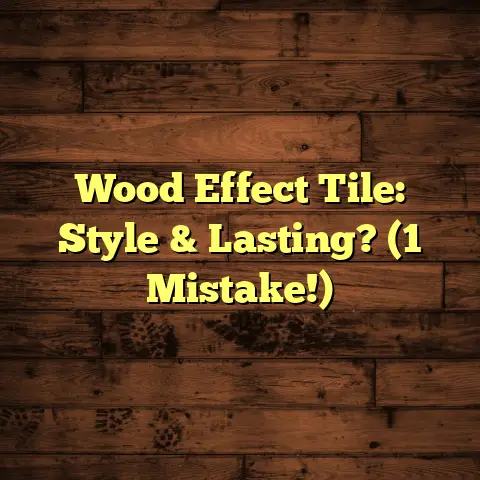Why Floors Creak & How To Fix It? (Silent Now!)
Ever have one of those evenings?
You’re chilling at home, maybe reading a book or watching TV, and creak!
There it is again.
That darn floor.
It’s like living in a haunted house, except the ghost is just… your floorboards.
Trust me, I’ve heard every creak, groan, and squeak imaginable.
And I know how frustrating it can be.
That’s why I’m writing this – to give you the lowdown on why your floors are singing (and not in a good way!) and, more importantly, how to silence them for good.
Let’s dive in and get your home back to being the peaceful oasis it should be.
Section 1: Understanding the Anatomy of a Floor
Okay, before we start diagnosing, let’s talk about what makes up a floor.
Think of it like a layered cake – each part plays a crucial role.
First, you’ve got your finished flooring.
This is the stuff you see and walk on:
-
Hardwood: Classic, beautiful, but can be a bit of a diva when it comes to moisture.
I’ve seen solid hardwood floors last for over a century with proper care, but I’ve also seen them buckle and warp in just a few years due to water damage.
-
Laminate: A budget-friendly option that mimics the look of wood or tile.
It’s pretty durable, but not waterproof, so beware of spills!
I’ve installed laminate floors in basements where the homeowner didn’t properly address moisture issues, and within a year, the edges were already starting to swell.
-
Tile: Great for kitchens and bathrooms, super durable and water-resistant.
However, grout can be a pain to keep clean, and a cracked tile can be a real eyesore.
-
Carpet: Soft, cozy, but can be a magnet for dirt and allergens.
Regular vacuuming is a must!
Underneath that pretty surface is the
subfloor.
This is usually made of plywood
or OSB (oriented strand board).
It provides a solid base for your finished
flooring.
Think of it as the foundation for your
cake.
And finally, we have the joists and beams.
These are the structural supports that run
underneath the subfloor, holding everything up.
They’re like the bones of your floor.
Now, here’s a key thing to remember: wood is a natural material, and it expands and contracts with changes in temperature and humidity.
That’s why you might notice your floors creaking more in the winter when the air is dry.
Section 2: Common Causes of Floor Creaking
Alright, let’s get down to the nitty-gritty. Why are your floors making those noises?
Here are some of the most common culprits:
1. Loose Floorboards
This is probably the most common reason for creaky floors, especially in older homes.
Over time, the nails or screws that hold the floorboards in place can loosen, creating gaps.
When you walk over these loose boards, they rub against the subfloor or adjacent boards, resulting in that telltale creak.
Think of it like this: imagine two pieces of wood rubbing together every time you take a step.
That’s the sound you’re hearing.
Foot traffic definitely contributes to this, especially in high-traffic areas like hallways or kitchens.
The constant pounding can gradually loosen the fasteners.
Age also plays a role.
As wood ages, it can dry out and shrink, making the problem even worse.
2. Improper Installation
Sometimes, the problem isn’t age, it’s just plain bad workmanship.
If your floors weren’t installed properly in the first place, they’re much more likely to creak.
Inadequate nailing or gluing is a common issue.
If the installers didn’t use enough fasteners or didn’t apply the adhesive properly, the floorboards won’t be securely attached to the subfloor.
This can lead to movement and, you guessed it, creaking.
I’ve seen cases where installers used the wrong type of nails or screws, which then corroded over time, weakening the connection.
Another common mistake is not leaving enough space for expansion and contraction.
As I mentioned earlier, wood needs room to move with changes in humidity.
If it’s crammed too tightly, it can buckle and creak.
3. Humidity and Moisture
Ah, humidity – the bane of every homeowner’s existence.
Changes in humidity can wreak havoc on your floors.
When the air is humid, wood absorbs moisture and expands.
When the air is dry, it loses moisture and contracts.
Leaks and water damage are even worse.
If water gets under your floors, it can cause the wood to rot and warp, creating even more movement and noise.
I once had a client who had a hidden plumbing leak under their kitchen floor.
By the time they noticed the creaking, the subfloor was completely waterlogged and had to be replaced.
4. Worn Out or Damaged Joists
Remember those structural supports I mentioned earlier?
Well, if they’re damaged or not properly supported, they can cause the floor to sag and move, leading to creaking.
Signs of joist damage include sagging floors, bouncing when you walk, or visible cracks in the joists themselves.
Insufficiently supported joists can also be a problem, especially in older homes.
Sometimes, the original joists weren’t strong enough to support the weight of the floor and furniture, or they’ve weakened over time.
I had a client with a beautiful old Victorian home.
The floors were creaking like crazy, and when I inspected the joists, I found that they were severely undersized and had started to sag in the middle.
We had to reinforce them with additional supports to solve the problem.
5. Subfloor Issues
Finally, let’s talk about the subfloor.
A compromised subfloor can definitely contribute to creaking.
If it’s damaged, warped, or not properly attached to the joists, it can create a weak foundation for your finished flooring.
This can lead to movement and, you guessed it, creaking.
Common subfloor problems include water damage, rot, and delamination (where the layers of plywood or OSB start to separate).
I’ve seen cases where the subfloor was simply too thin for the type of flooring that was installed on top of it.
This can cause the subfloor to flex and bend underfoot, leading to creaking.
Section 3: Diagnosing the Problem
Okay, now that you know the potential causes, how do you figure out what’s causing your floors to creak?
Here’s a step-by-step guide:
-
Listen carefully: Pay attention to where the creaking is coming from.
Is it localized to one spot, or is it widespread?
Does it happen every time you step in a certain area, or is it more random?
Try to pinpoint the exact location of the creak.
-
Walk the walk: Walk slowly and deliberately over the area where you hear the creaking.
Try different walking patterns – heel-to-toe, side-to-side, etc.
Can you feel any movement or flexing in the floor?
This can help you identify loose boards or weak spots in the subfloor.
-
Inspect visually: Get down on your hands and knees and take a close look at the floor.
Are there any visible gaps between the floorboards?
Are any of the boards loose or uneven?
Do you see any signs of water damage, such as stains or discoloration?
If you have access to the basement or crawl space, inspect the joists and subfloor from below.
Look for signs of damage, rot, or sagging.
-
Use a helper: Have someone walk over the creaky area while you listen from below.
This can help you pinpoint the exact source of the noise.
You can also use a stethoscope to amplify the sound.
-
Consider the season: As I mentioned earlier, humidity can play a big role in floor creaking.
If the creaking is worse in the winter, it’s likely due to dry air causing the wood to shrink.
If it’s worse in the summer, it could be due to excess moisture.
It’s important to determine whether the issue is localized or widespread.
If it’s just one or two spots, the problem is likely a loose floorboard or a minor subfloor issue.
If it’s widespread, it could be a sign of a more serious problem, such as damaged joists or a major moisture issue.
Safety First!
When inspecting your floors, be careful not to damage them further.
Avoid using excessive force or prying tools that could scratch or dent the surface.
If you’re inspecting the joists or subfloor from below, wear safety glasses and a dust mask to protect yourself from debris.
And if you’re not comfortable working in tight spaces or dealing with structural issues, it’s always best to call a professional.
Section 4: Solutions to Fix Creaky Floors
Alright, you’ve diagnosed the problem.
Now, let’s talk about how to fix it.
Here are some solutions for common creaky floor issues:
1. Simple Fixes for Loose Floorboards
-
Screws: This is often the easiest and most effective solution for loose floorboards.
Simply drive a screw through the floorboard and into the joist or subfloor below.
Use screws that are long enough to penetrate at least 1 inch into the joist or subfloor.
Countersink the screws slightly so they don’t protrude above the surface of the floor.
You can then fill the screw holes with wood putty or a wood filler that matches the color of your floor.
I recommend using trim-head screws, as they have a smaller head and are less noticeable.
-
Nails: If screws aren’t an option, you can use nails to secure loose boards.
Use ring-shank nails, which have ridges that help them grip the wood more securely.
Again, make sure the nails are long enough to penetrate at least 1 inch into the joist or subfloor.
Set the nails below the surface of the floor using a nail set, and then fill the holes with wood putty or filler.
-
Wood Glue: For added stability, you can apply wood glue to the underside of the loose floorboard before screwing or nailing it down.
Use a syringe or a small nozzle to inject the glue into the gap between the floorboard and the subfloor.
Then, clamp the floorboard in place until the glue dries.
I like to use a polyurethane-based wood glue, as it’s very strong and waterproof.
2. Addressing Improper Installation
-
Reinforcing: If your floors were poorly installed, you may need to reinforce them to prevent creaking.
This could involve adding more screws or nails to secure the floorboards to the subfloor, or installing additional supports under the joists.
If you’re dealing with a floating floor, such as laminate or engineered wood, you may need to add shims to level out any uneven spots.
I’ve used self-leveling compound to fix uneven subfloors before installing new flooring.
It’s a bit messy, but it creates a perfectly flat surface for the new floor.
-
DIY Correction: Depending on the extent of the problem, you may be able to correct some of the installation issues yourself.
For example, if the floorboards are too close together, you can use a chisel or a saw to create a small gap for expansion.
If the subfloor is uneven, you can sand it down or add shims to level it out.
However, if the installation is severely flawed, it may be best to hire a professional to redo the job.
3. Managing Humidity Levels
-
Dehumidifiers: In humid climates, using a dehumidifier can help to reduce the moisture content in the air, preventing your floors from expanding and contracting excessively.
Place the dehumidifier in the room where the creaking is most prevalent, and set it to maintain a humidity level of around 40-50%.
I recommend using a dehumidifier with a built-in humidistat, which will automatically turn on and off to maintain the desired humidity level.
-
Ventilation: Proper ventilation can also help to control indoor humidity.
Make sure your bathrooms and kitchens have exhaust fans that vent to the outside, and use them whenever you’re showering or cooking.
Open windows and doors on dry days to allow fresh air to circulate.
I always advise my clients to install a whole-house ventilation system if they’re renovating their home.
It’s a bit of an investment, but it can significantly improve indoor air quality and prevent moisture problems.
-
Regular Maintenance: Regular maintenance can help to prevent moisture damage.
Clean up spills immediately, and avoid leaving standing water on your floors.
Check your plumbing regularly for leaks, and repair them promptly.
Make sure your gutters and downspouts are clean and functioning properly to prevent water from pooling around your foundation.
4. Repairing or Reinforcing Joists
-
Inspection: Before you can repair or reinforce your joists, you need to inspect them carefully to assess the extent of the damage.
Look for signs of rot, cracks, or insect infestation.
Use a moisture meter to check the moisture content of the wood.
If the moisture content is above 20%, the wood is at risk of rotting.
I always wear a respirator when inspecting old joists, as they can be covered in mold and dust.
-
Repair: If the joists are only slightly damaged, you may be able to repair them.
For example, if there are small cracks, you can fill them with epoxy or wood filler.
If there is minor rot, you can scrape away the damaged wood and apply a wood preservative.
However, if the joists are severely damaged, they will need to be replaced.
-
Reinforcing: If the joists are sagging or not strong enough to support the weight of the floor, you can reinforce them with additional supports.
This could involve sistering new joists to the existing ones, or installing additional posts or beams to provide extra support.
I’ve used steel beams to reinforce joists in older homes where the original joists were significantly undersized.
It’s a more expensive solution, but it’s very effective.
5. Fixing Subfloor Problems
-
Assessment: The first step in fixing subfloor problems is to assess the extent of the damage.
Look for signs of water damage, rot, or delamination.
Check the subfloor for levelness and stability.
If the subfloor is only slightly damaged, you may be able to repair it.
For example, if there are small areas of delamination, you can glue them back together with construction adhesive.
-
Repair: If the subfloor is more severely damaged, you will need to replace it.
This involves removing the damaged section of subfloor and replacing it with a new piece of plywood or OSB.
Make sure the new subfloor is the same thickness as the old one, and that it’s properly attached to the joists.
I always use construction adhesive in addition to screws or nails when installing new subfloor.
It creates a much stronger bond.
-
Replacement: In some cases, it may be necessary to replace the entire subfloor.
This is a more extensive project, but it may be the only way to ensure that your floors are stable and creak-free.
When replacing the subfloor, be sure to inspect the joists and repair any damage before installing the new subfloor.
Section 5: Long-Term Maintenance and Prevention
Okay, you’ve fixed your creaky floors.
Now, how do you keep them from coming back?
Here are some strategies for long-term maintenance and prevention:
-
Regular Inspections: Regularly inspect your floors for signs of damage or wear.
Look for loose boards, gaps, or water stains.
Check the joists and subfloor from below for signs of rot or sagging.
The earlier you catch a problem, the easier it will be to fix.
-
Timely Repairs: Don’t delay repairs.
If you notice a loose board or a small leak, fix it immediately.
Ignoring small problems can lead to bigger, more expensive problems down the road.
-
Control Humidity: As I’ve mentioned before, controlling humidity is crucial for preventing floor creaking.
Use a dehumidifier in humid climates, and make sure your home is properly ventilated.
-
Proper Cleaning: Clean your floors regularly according to the manufacturer’s instructions.
Avoid using harsh chemicals or abrasive cleaners, as they can damage the finish and cause the wood to dry out.
-
Professional Help: Don’t be afraid to call a professional when necessary.
If you’re not comfortable working on your floors yourself, or if you’re dealing with a complex problem, it’s always best to hire a qualified flooring contractor.
A professional can diagnose the problem accurately and provide the best solution for your specific situation.
Conclusion
Creaky floors can be a real nuisance, but they don’t have to ruin your peace and quiet.
By understanding the causes of floor creaking and taking the appropriate steps to fix them, you can reclaim the serenity of your home.
Remember, addressing creaky floors isn’t just about silencing the noise.
It’s about ensuring the structural integrity of your home and creating a comfortable and enjoyable living space.
So, take action!
Inspect your floors, diagnose the problem, and implement the solutions I’ve outlined in this article.
With a little bit of effort and the right tools, you can transform your creaky floors into a source of comfort and pride.
Now go forth and conquer those creaks! Your silent, peaceful home awaits.





